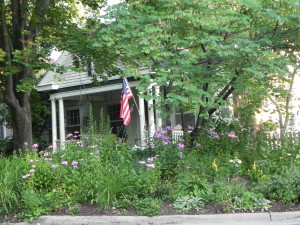DELICIOUS ACORNS
Every fall zillions of acorns cascade down into lawns, tumble roll off roofs, and pile up in American driveways. Raking them up is a dreaded autumn chore. Anyone who collects and disposes of acorns is tossing away delicious food.
Too many people believe these big oak nuts are toxic, perhaps because they are bitter when eaten raw. For deer, woodchucks, squirrels blue jays and a host of other wild creatures, acorns are a bonanza of nutritious food so important that a heavy acorn crop means a winter of good health while a sparse one spells starvation.
Native Americans enthusiastically collected, processed, stored and ate acorns. And they are a common food in some European cultures. A great acorn benefit in the days before refrigeration was the ability to store them indefinitely, providing food if crops failed or game was scarce. Far too many modern people don’t realize that acorns are delicious if properly prepared.
Dozens of oak species live around the world. In North America much of the eastern hardwood forest is dominated by oaks with several scattered scrubby species in the southwest and many larger ones near the Pacific coast. Even on the Great Plains and in the Rocky Mountains, where native oaks either don’t occur naturally or are uncommon, they have been planted in nearly every town and city.
Although there are many oak species all fall within one of two categories:
White Oak Group: The leaves of these oaks have rounded lobes and generally the trees produce an abundant acorn crop irregularly. Often a few falls go by with a sparse crop nuts. Then during a banner year, millions of acorns carpet a forest floor. Almost every year there will be a tree or two here and there with a heavy crop while others nearby are barren. Common white oak group species are the bur, white, and chestnut oaks. Acorns in this group have the lowest tannin content, are usually large and require the least processing. If white oaks live in your area these are the acorns to gather.
Black (or Red) Oak Group: These trees have leaves with lobes that end in points. The acorns are usually smaller than those in the white oak group but normally trees in this group produce a more reliable crop. Typical species are pin, black and red oaks.
Nearly all oaks produce acorns that can be processed for food, but because those in the white oak group produce the largest nuts with lowest tannin content, we exclusively process acorns gleaned from under white and bur oak trees. We leave the black oak group acorns for the squirrels.
Tip: When you’ve found a prolific oak just starting to drop its nuts carefully slice an acorn or two in half with a paring or pocket knife and use the point of the knife to pry the kernel out of its husk. Taste it. If it’s only modestly bitter you’ve found great acorns. If it’s very bitter seek out another tree. Although white and bur oaks usually have the sweetest acorns the tannin content varies from tree to tree, so gathering the sweetest acorns reduces later work removing this bitter substance. A white or bur oak tree producing sweet acorns may be growing next to a tree of the same species with bitter kernels. Gather the sweet ones.
HOW TO PROCESS ACORNS INTO DELICIOUS FOOD
Here is how we convert acorns into delicious food:
• Collect acorns as soon as they fall from the tree. Normally oaks begin dropping nuts in late August. September is the prime gathering month. Usually the easiest way to gather a bunch of acorns is to find a prolific white or bur oak growing over a parking lot or driveway. It’s easier sweeping up a few gallons of acorns from pavement than picking them out of the forest floor or lawn. Various insects realize that acorns are good food and quickly bore into fallen nuts. So, beat the squirrels and bugs to the acorns, pick a few gallons and bring them home. Collect only perfect acorns lacking cracks, sprouts or holes.
• Put newly collected acorns in large zip lock bags and freeze them. Freezing kills insects that may be hiding in the acorns and prevents sprouting and mold. Processing acorns is fairly tedious and time consuming. We are usually busy during acorn season and have more processing time when winter hits. So, we store our acorns in the freezer until later. Processing acorns while sitting next to a cozy January woodstove and listening to music is a pleasant winter activity. But, if you want to immediately process acorns after collecting them freezing is optional.
• Put a few gallons of fresh or frozen acorns in a large pot, like a canning pot, nearly fill it with water, and boil for 15 or 20 minutes. Boiling does two things. It softens the husks, making for easier shelling and it removes some tannin. As tannin leaches out of the nuts the water will darken. Let the boiled acorns cool down and drain them. Collect your tools. You’ll need a sharp paring knife, a cutting board, two pots and a good light source.
• Remove the kernels by cutting each acorn in half lengthwise. It should be easy to cut through the water softened husk. Use the point of the knife to pop the kernels into one bowl and the husks in the other. We compost husks They also make good mulch.
• Pour the kernels into a large pot of boiling water and slowly boil them for about ten minutes. As tannins leach out of the nuts the water will darken. While the nuts are boiling bring another pot of water to a boil. Drain the nuts from the first pot and put the kernels into the second pot of clean boiling water. If your acorns were sweet only two or three boilings will remove the tannin. When boiling water darkens only slightly you know you’ve leached out most of the tannin and there will be little bitterness left. Red or pin oak acorns could take five or six boilings to remove tannin.
• Once the tannin is gone thoroughly drain the acorns in a large colander.
• Spread the drained water-softened acorn kernels on a cookie sheet one layer deep. Dry them in an oven on low heat, stirring occasionally. The object is to dry them, not cook them. This part takes a couple of hours. When dry, the kernels will be rock hard.
Once they are completely dry, hard and cooled the acorns can either be placed in airtight jars or other storage containers or immediately ground into flour. Dried acorns will keep for years and unground kernels can be added to stews much like you might add dried beans. This is how Native Americans commonly used them.
Or
• Place the hard dry kernels in a heavy duty blender or hand or electric mill designed for grinding grain. Grind them to the texture of fine flour. Store in an airtight container. Sift the flour to separate out harder kernels. These you can store separately and add to soups where they soften and add a rich earthy flavor to the broth.
We use acorn kernels in soups and the flour in recipes such as Boston Steamed Brown Bread, cookies and muffins. Here are two of our favorite acorn recipes:
Acorn Cookies from the Kitchen of Yvonne Fellows
½ Cup cooking oil ½ tsp. almond extract
½ Cup honey ¼ Cup acorn flour
2 beaten eggs 1 ¾ Cup regular flour (if whole wheat increase the liquid)
Pre-heat oven to 375 degrees. Blend oil and honey. Beat eggs into the mix. Add almond extract then the wheat and acorn flours. Batter should be cookie dough consistency so add more flour if needed. Drop by spoons full onto greased baking sheet. Bake 15 minutes at 375 degrees.
Acorn Muffins adapted from a recipe by Yvonne Fellows
One beaten egg ¼ Cup sugar
One Cup milk 1 ¾ Cups flour
(mix of whole wheat and white or pastry)
2 TBSP vegetable oil ¼ Cup Acorn sifted flour
½ Cup molasses or honey
(I use a combination) 2 tsp baking powder
1tsp vanilla ½ baking soda
Pre-heat oven to 375 degrees. Grease muffin tins or use baking cups. Mix wet and dry ingredients in separate bowls. Blend wet and dry ingredients together until just moist. Some small lumps are OK. Fill muffin tins or baking cups 2/3 full. Bake at 375 degrees for 20 – 25 minutes. Tops of muffins should spring back when done. To prevent dryness, avoid over baking. Serve warm with honey and butter.


